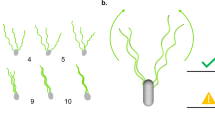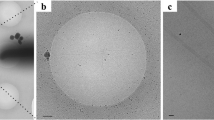Abstract
Filaments of bacterial flagella are perfect tubular stackings polymerized out of just one kind of building block: the flagellin protein. Surprisingly, they do not form straight tubes, but exhibit a symmetry-breaking coiling into helical shapes which is essential for their biological function as cell ``propeller''. The co-existence of two conformational states for flagellin within the filament is believed to be responsible for the helical shapes by producing local misfit which results in curvature and twist. In this paper, we present a coarse-grained description with an elastic energy functional for the filament derived from its microscopic structure. By minimising this functional we can answer the question of spatial distribution of flagellin states which is crucial for the observed coupling of curvature and twist. Our approach extends a classical theory of Calladine, which had to assume this spatial distribution from the outset.
Similar content being viewed by others
References
Asakura, S.: Polymerization of flagellin and polymorphism of flagella. Adv. Biophys. 1, 99–155 (1970)
Berg, H.: The rotary motor of bacterial flagella. Annu. Rev. Biochem. 72, 19–54 (2003)
Bishop, R.: There is more than one way to frame a curve. Am. Math. Monthly 82, 246 (1975)
Braides, A.: Γ-convegence for beginners. Oxford UP, 2002
Calladine, C.: Design requirements for the construction of bacterial flagella. J. Theor. Biol. 57, 469–489 (1976)
Calladine, C.: Change of waveform in bacterial flagella: the role of mechanics at the molecular level. J. Molec. Biol. 118, 457–479 (1978)
Calladine, C.: Construction of bacterial flagellar filaments, and aspects of their conversion to different helical forms. In: W. Amos, J. Duckett, (Eds.), Prokaryotic and eukaryotic flagella, Proc. 35th Symp. of Soc. Exper. Biol. pp. 33–51. CUP (1982)
Dacorogna, B.: Direct methods in the calculus of variations. Springer, 1989
Evans, L.: Partial differential equations. AMS, 1998
Goldstein, R., Goriely, A., Huber, G., Wolgemuth, C.: Bistable helices. Phys. Rev. Lett. 84, 1631–1634 (2000)
Hasegawa, K., Yamashita, I., Namba, K.: Quasi- and nonequivalence in the structure of bacterial flagellar filament. Biophys. J. 74, 569–575 (1998)
Howard, J.: Mechanics of Motor Proteins and the Cytoskeleton. Sinauer, 2001
Ireta, J., Neugebauer, J., Scheffler, M., Rojo, A., Galván, M.: Structural transitions in the polyalanine α-helix under uniaxial strain. Available online: w3.rz-berlin.mpg.de/~ireta/member/highlights/pes_helix-v5.pdf
Kim, M., Bird, J., Parys, A., Breuer, K., Powers, T.: A macroscopic scale model of bacterial flagellar bundling. PNAS 100 (23), 15,481–15,485 (2003)
Namba, K., Vonderviszt, F.: Molecular architecture of bacterial flagellum. Quart. Rev. of Biophys. 30 (1), 1–65 (1997)
Samatey, F., Imada, K., Nagashima, S., Vonderviszt, F., Kumasaka, T., Yamamoto, M., Namba, K.: Structure of the bacterial flagellar protofilament and implications for a switch for supercoiling. Nature 410, 331–337 (2001)
Srigiriraju, S., Powers, T.: Continuum model for polymorphism of bacterial flagella. Phys. Rev. Lett. 94, 248,101 (2005)
Turner, L., Ryu, W., Berg, H.: Real-time imaging of fluorescent flagellar filaments. J. of Bacteriol. 182 (10), 2793–2801 (2000)
Yamashita, I., Hasegawa, K., Suzuki, H., Vonderviszt, F., Mimori-Kiyosue, Y., Namba, K.: Structure and switching of bacterial flagellar filaments studied by X-ray fiber diffraction. Nature Struct. Bio. 5 (2), 125–132 (1998)
Yonekura, K., Maki-Yonekura, S., Namba, K.: Complete atomic model of the bacterial flagellar filament by electron cyromicroscopy. Nature 424, 643–650 (2003)
Author information
Authors and Affiliations
Corresponding author
Rights and permissions
About this article
Cite this article
Friedrich, B. A mesoscopic model for helical bacterial flagella. J. Math. Biol. 53, 162–178 (2006). https://doi.org/10.1007/s00285-006-0380-8
Received:
Published:
Issue Date:
DOI: https://doi.org/10.1007/s00285-006-0380-8




